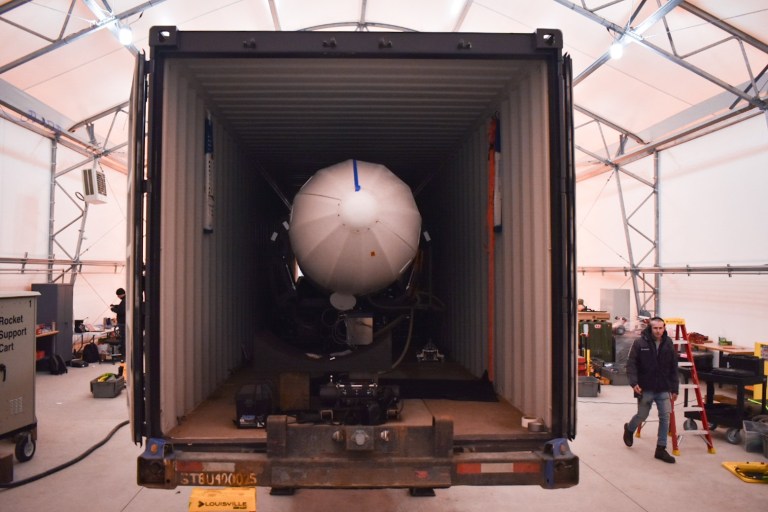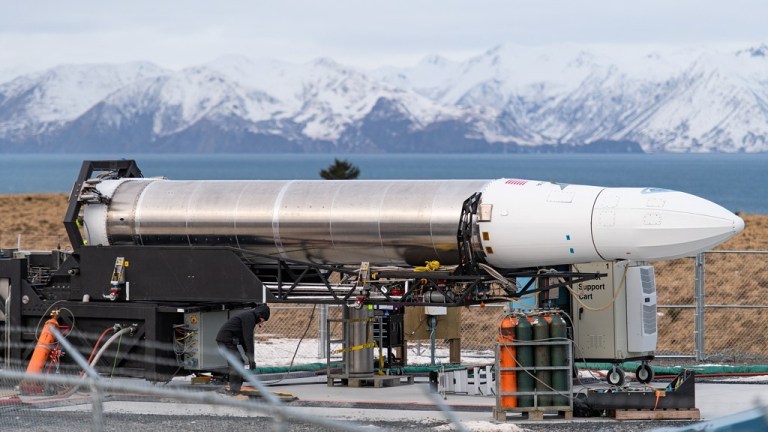
Astra CEO Chris Kemp is keeping expectations low for the company’s upcoming launch at the Pacific Spaceport Complex on Kodiak Island’s Narrow Cape.
“We’re taking a rocket that’s never flown before and we’re attempting to reach orbit,” Kemp said. “So, it’s an incredibly difficult challenge and we’re trying to lower expectations as much as possible that we’ll get everything right the first time,” he said in an interview in early February.
The launch is a part of the Defense Advanced Research Projects Agency (DARPA) Launch Challenge to place satellites in low Earth orbit, twice, within a two-week time frame.
Launch teams typically work for months or years to set up a new rocket. But that timeline has been reduced dramatically, from years to days.
Taking a break from launch preparations at the spaceport recently, DARPA project manager Todd Master said the challenge encourages rocket designs that are flexible, upgradeable and ready to go in a short period of time.
“The ability to sort of be adaptable in that sense is not something we’ve ever done,” Master said. “We sort of pre-planned these things very, very long in advance. And so we’re trying to say, ‘How can we do this quickly? How can we do it in a flexible way?’”
Astra is part of a new wave of rocket companies focused on achieving those goals.
Instead of spending five or 10 years building a rocket, Astra has a nine-month production schedule that makes it easy to make adjustments along the way.
Kemp said that while producing lots of designs quickly might seem slapdash, ultimately it’s supposed to result in a more reliable rocket. The idea is that more models means more data collected, and therefore higher reliability. But that is not their absolute top priority.
“Our number one priority is safety, not reliability,” Kemp said. “So (what) we designed our systems for is to be safe.”
Kemp also said they want want them to be most cost-effective and reliable.
“Because reliability at any cost will keep people out of space for the next hundred years,” Kemp said.
Essentially, space travel is so inherently risky, Kemp wants to focus on building a safe, cheap rocket, rather than chasing the virtually impossible goal of a 100 percent success rate.
That’s part of the reason his expectations are low for this launch. Astra’s rocket is basically brand new.
So, in addition to the tight launch schedule, Kemp said there are a lot of factors that they can’t test their design for. They expect the rocket will launch, “leave Alaska and fly away.” Beyond that, he said they’re just hoping to learn as much as they can. The longer the flight lasts, the more information they’ll get.
“If the flight doesn’t perform absolutely everything perfectly, deliver a payload into the perfect orbit and win the DARPA challenge, we’re fine with that.” Kemp said with a laugh. “Because there’s another rocket right behind it, and we’ll take everything we learned, we’ll make some changes… and apply again.”

Many Kodiak residents have expressed concern about Astra’s launches on Narrow Cape in 2018, one of which resulted in spilled fuel and debris.
Kemp doesn’t characterize those launches as failures. He said they hit nearly all of their objectives. He estimates that cleanup, including having to remove and replace more than 230 tons of contaminated soil, cost less than $50,000. Astra is held financially responsible for any cleanup costs and carries $50 million insurance on each launch.
Amid some community concern — primarily about potential environmental damage — Alaska Aerospace Corporation has been positioning the spaceport as a prime location for commercial space flight.
Launching directly over the Pacific Ocean doesn’t pose nearly as much risk as launching near heavily populated areas in the Lower 48. And state investment in the spaceport, along with military presence on the island, provides a high level of infrastructure for such a remote place.
“The things that we’re doing here at Kodiak is similar to what you’d do at a federal range. But the agility, the flexibility, the responsiveness is right in line with what DARPA is trying to do with Astra,” said Mark Lester, CEO of Alaska Aerospace Corporation. “So I think it’s exciting for Kodiak, I think it’s exciting for Alaska, to be right at the forefront of launching this type of mission.”
Kodiak’s spaceport will host two launches for the Launch Challenge. If Astra completes both successfully, they’ll win $12 million. Astra is the last remaining competitor in this year’s challenge, after the other finalists either dropped out or went bankrupt.
The first launch was expected as early as Feb. 27. But the launch team chose to delay it until Feb. 29 at the earliest.
